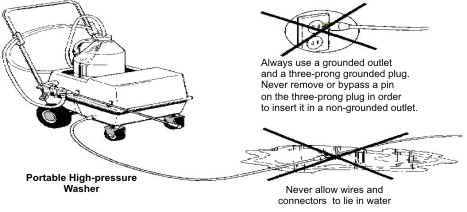Electric High-pressure
Washers:
A potential electrocution hazard
Accidents in the service bays that have resulted in the unfortunate loss
of lives tell us we can never compromise on safety. Incidents of service
staff getting crushed by a vehicle that slipped off a car lift or perhaps
getting electrocuted while using a high-pressure washer underscore the need
to educate service personnel in safety procedures.
We will discuss the safe handling of electric high-pressure washers in
this issue. The Safety Corner has collated information from Caltex’s
Occupational Safety Guidelines in Service Bays and from retailers who were
kind enough to share their experience in the use of this potentially
hazardous Wash Bay equipment.
A few points to remember:
-
The use of a electric high-pressure washer for cleaning vehicles can
be a hazard. Wires, metal objects, water, and even our bodies can
conduct electricity and carry it from one place to another. When we
touch an exposed wire with wet hands we run the risk of electrocution.

-
Caltex’s Service Bay Safety
Manual recommends that the electric
pumps of pressure washers be placed in a dry area, where they are not exposed to the nozzle spray or to the mist
generated by the washing operation. A long water hose is used to reach
the vehicle being washed.
In
actual practice, pressure washers are typically positioned next to the vehicle that is being washed.
This exposes them to mist and spray. Should the motor, the wiring, or the
switch get wet, mild or severe grounding will occur, causing electrical
shock.
How do we go about making sure water does not get into the electricals
(motor, wires, switch) of the washer?
Here is the advice of experienced
dealers:
-
For open types (e.g., Wuli), cover or wrap electricals with
poor conductors, i.e. materials like trapal, old tire tubes, etc. Also
consider detaching the motor switch and moving it to a location away
from the unit.
-
For closed units ( e.g. Karcher), any major problems that involve
opening the case, such as a dead motor, must be handled by the
authorized repair center.
-
Use only a heavy-duty power cord, preferably one that has a grounded
plug (three-prong) and keep any wires out of standing water.
-
Electrical connections should be as far away as possible from the
vehicle being washed. That is why you want a long, long hose.
-
It also helps to use a protective outfit. Protect eyes by wearing
goggles. Wear rubber gloves and boots that provide some insulation.
-
If your hands are wet, do NOT touch anything electrical. Therefore
never turn the switch on and off with wet hands.
-
Maintain your high-pressure washer. Do not use a washer
whose power cord insulation is worn out and frayed.
Plugging in a damaged power cord could give a painful shock, or it could
heat up and start a fire. Inspect hoses and replace those that are cut or
abraded. Destroy any hose considered unserviceable to prevent its further
use.
|
![]()